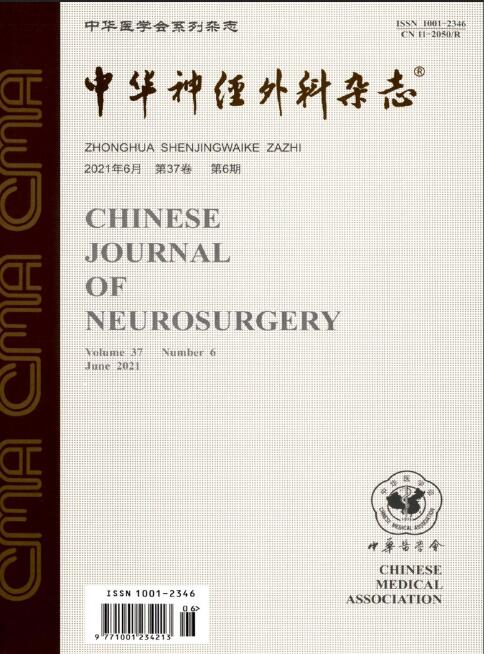Consistency of neurovascular relationship between multimodal image fusion 3D reconstruction and intraoperative findings of microvascular decompression for primary trigeminal neuralgia
Q4 Medicine
引用次数: 0
Abstract
Objective To explore the consistency of neurovascular relationships between multimodal image fusion 3D reconstruction and intraoperative findings in microvascular decompression (MVD) for primary trigeminal neuralgia (PTN). Methods A retrospective analysis was conducted on the clinical data of 50 PTN patients treated with MVD at Department of Neurosurgery, Qingdao University Hospital from January to November 2018. All subjects underwent three-dimensional time-flying magnetic resonance angiography (3D-TOF-MRA) and three-dimensional cyclic phase steady-state acquisition rapid imaging (3D-FIESTA) sequences. Then, the 3D-slicer software was used to reconstruct the multimodal fusion 3D image. Multimodal image fusion 3D reconstruction images and surgical video were analyzed to determine the offending vessels responsible for trigeminal neuralgia. At the same time, the direction of compression, compression site and compression degree of the trigeminal nerve were analyzed. Kappa consistency test method was used to judge the consistency of the two approaches above. Results With MVD set as the standard, the accuracies of multimodal image fusion 3D reconstruction images in determining the offending vessels, direction of compression, compression site and the degree of compression were 92.0% (46/50), 92.0% (46/50), 96.0% (48/50) and 58.0% (29/50), respectively. Multimodal image fusion 3D reconstruction images and MVD showed high consistency in judging offending vessels, compression direction and compression position (Kappa values: 0.729, 0.903 and 0.955 respectively, all P<0.001). However, the consistency was poor in judging the degree of compression of offending vessels to the trigeminal nerve (Kappa value=0.227, P=0.002). The degree of compression was higher in intraoperative findings of MVD than that revealed by multimodal image fusion three-dimensional reconstruction (mean values: 2.57 and 1.58 respectively, Z=-4.499, P<0.001). Conclusions Preoperative multi-modal image fusion 3D reconstruction could help accurately determine the offending vessel, compression direction and compression position of PTN, which seems highly consistent with intraoperative findings of MVD. Preliminary speculation could be used as one of the methods facilitating preoperative diagnosis. Key words: Trigeminal neuralgia; Multimodal image fusion; Microvascular decompression; Neurovascular relationship; Computer-aided diagnosis多模态图像融合三维重建与三叉神经痛微血管减压术中表现神经血管关系的一致性
目的探讨多模式图像融合三维重建与原发性三叉神经痛微血管减压术中表现的神经血管关系的一致性。方法对青岛大学医院神经外科2018年1月至11月收治的50例经MVD治疗的PTN患者的临床资料进行回顾性分析。所有受试者均接受了三维时间飞行磁共振血管造影术(3D-TOF-MRA)和三维循环相位稳态采集快速成像(3D-FESTA)序列。然后,使用3D切片器软件重建多模式融合的3D图像。对多模式图像融合三维重建图像和手术视频进行分析,以确定引起三叉神经痛的病变血管。同时对三叉神经的压迫方向、压迫部位和压迫程度进行了分析。采用Kappa一致性检验方法来判断上述两种方法的一致性。结果以MVD为标准,多模式图像融合三维重建图像在确定病变血管、压迫方向、压迫部位和压迫程度方面的准确率分别为92.0%(46/50)、92.0%(46/50)、96.0%(48/50)和58.0%(29/50)。多模式图像融合三维重建图像和MVD在判断病变血管、压迫方向和压迫位置方面具有高度一致性(Kappa值分别为0.729、0.903和0.955,均P<0.001),判断侵犯血管对三叉神经压迫程度的一致性较差(Kappa值=0.227,P=0.002)。MVD术中表现的压迫程度高于多模式图像融合三维重建显示的压迫程度(平均值分别为2.57和1.58,Z=-4.499,P<0.001)融合三维重建有助于准确确定PTN的侵犯血管、压迫方向和压迫位置,与MVD的术中表现高度一致。初步推测可作为促进术前诊断的方法之一。关键词:三叉神经痛;多模式图像融合;微血管减压;神经血管关系;计算机辅助诊断
本文章由计算机程序翻译,如有差异,请以英文原文为准。
求助全文
约1分钟内获得全文
求助全文
来源期刊

中华神经外科杂志
Medicine-Surgery
CiteScore
0.10
自引率
0.00%
发文量
10706
期刊介绍:
Chinese Journal of Neurosurgery is one of the series of journals organized by the Chinese Medical Association under the supervision of the China Association for Science and Technology. The journal is aimed at neurosurgeons and related researchers, and reports on the leading scientific research results and clinical experience in the field of neurosurgery, as well as the basic theoretical research closely related to neurosurgery.Chinese Journal of Neurosurgery has been included in many famous domestic search organizations, such as China Knowledge Resources Database, China Biomedical Journal Citation Database, Chinese Biomedical Journal Literature Database, China Science Citation Database, China Biomedical Literature Database, China Science and Technology Paper Citation Statistical Analysis Database, and China Science and Technology Journal Full Text Database, Wanfang Data Database of Medical Journals, etc.
 求助内容:
求助内容: 应助结果提醒方式:
应助结果提醒方式:


